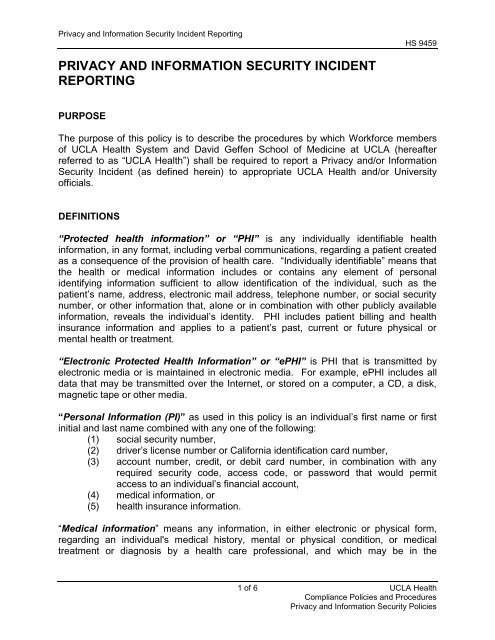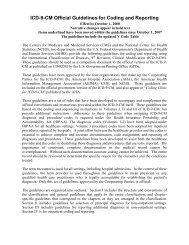HS 9459 Privacy and Information Security Incident Reporting
HS 9459 Privacy and Information Security Incident Reporting
HS 9459 Privacy and Information Security Incident Reporting
You also want an ePaper? Increase the reach of your titles
YUMPU automatically turns print PDFs into web optimized ePapers that Google loves.
<strong>Privacy</strong> <strong>and</strong> <strong>Information</strong> <strong>Security</strong> <strong>Incident</strong> <strong>Reporting</strong><strong>HS</strong> <strong>9459</strong>PRIVACY AND INFORMATION SECURITY INCIDENTREPORTINGPURPOSEThe purpose of this policy is to describe the procedures by which Workforce membersof UCLA Health System <strong>and</strong> David Geffen School of Medicine at UCLA (hereafterreferred to as “UCLA Health”) shall be required to report a <strong>Privacy</strong> <strong>and</strong>/or <strong>Information</strong><strong>Security</strong> <strong>Incident</strong> (as defined herein) to appropriate UCLA Health <strong>and</strong>/or Universityofficials.DEFINITIONS“Protected health information” or “PHI” is any individually identifiable healthinformation, in any format, including verbal communications, regarding a patient createdas a consequence of the provision of health care. “Individually identifiable” means thatthe health or medical information includes or contains any element of personalidentifying information sufficient to allow identification of the individual, such as thepatient’s name, address, electronic mail address, telephone number, or social securitynumber, or other information that, alone or in combination with other publicly availableinformation, reveals the individual’s identity. PHI includes patient billing <strong>and</strong> healthinsurance information <strong>and</strong> applies to a patient’s past, current or future physical ormental health or treatment.“Electronic Protected Health <strong>Information</strong>” or “ePHI” is PHI that is transmitted byelectronic media or is maintained in electronic media. For example, ePHI includes alldata that may be transmitted over the Internet, or stored on a computer, a CD, a disk,magnetic tape or other media.“Personal <strong>Information</strong> (PI)” as used in this policy is an individual’s first name or firstinitial <strong>and</strong> last name combined with any one of the following:(1) social security number,(2) driver’s license number or California identification card number,(3) account number, credit, or debit card number, in combination with anyrequired security code, access code, or password that would permitaccess to an individual’s financial account,(4) medical information, or(5) health insurance information.“Medical information” means any information, in either electronic or physical form,regarding an individual's medical history, mental or physical condition, or medicaltreatment or diagnosis by a health care professional, <strong>and</strong> which may be in the1 of 6 UCLA HealthCompliance Policies <strong>and</strong> Procedures<strong>Privacy</strong> <strong>and</strong> <strong>Information</strong> <strong>Security</strong> Policies
<strong>Privacy</strong> <strong>and</strong> <strong>Information</strong> <strong>Security</strong> <strong>Incident</strong> <strong>Reporting</strong><strong>HS</strong> <strong>9459</strong>possession of or derived from a health care provider, health care service plan,pharmaceutical company or contractor. “Health insurance information” means anindividual's health insurance policy number or subscriber identification number, anyunique identifier used by a health insurer to identify the individual, or any information inan individual's application <strong>and</strong> claims history, including any appeals records. Medicalinformation <strong>and</strong> health insurance information for patients are also considered to be PHI.“Restricted <strong>Information</strong>” (as defined by UC Policy IS-3, Electronic <strong>Information</strong><strong>Security</strong>) describes any confidential or Personal <strong>Information</strong> that is protected by law orpolicy <strong>and</strong> that requires the highest level of access control <strong>and</strong> security protection,whether in storage or in transit. This includes Personal <strong>Information</strong>, PHI <strong>and</strong> ePHI asdefined in this section but could also include other types of information such as researchdata.“<strong>Information</strong> <strong>Security</strong> <strong>Incident</strong> or <strong>Security</strong> <strong>Incident</strong>” is the attempted or successfulunauthorized access to, use, disclosure, modification, or destruction of information orinterference with system operations in an information system. (45 C.F.R. section164.304).“<strong>Privacy</strong> <strong>Incident</strong>” is the loss of control, compromise, unauthorized disclosure,unauthorized acquisition, unauthorized access, or any similar term referring to situationswhere persons other than authorized users, <strong>and</strong> for an other than authorized purpose,have access or potential access to Restricted <strong>Information</strong>, in any format, includingverbal.POLICYUCLA Workforce members shall report any suspected <strong>Privacy</strong> or <strong>Information</strong> <strong>Security</strong><strong>Incident</strong>s immediately to the <strong>Privacy</strong> <strong>and</strong> <strong>Information</strong> <strong>Security</strong> Offices(<strong>Privacy</strong>InfoSec@mednet.ucla.edu) <strong>and</strong> their supervisor(s).I. <strong>Privacy</strong> <strong>and</strong> <strong>Information</strong> <strong>Security</strong> <strong>Incident</strong>sA. <strong>Privacy</strong> <strong>Incident</strong>sCalifornia law <strong>and</strong> the Breach Notification Rule require notification undercertain circumstances for the unauthorized access to or unauthorizedexposure of specific kinds of Restricted <strong>Information</strong>, including e-PHI <strong>and</strong>patient information.<strong>Privacy</strong> <strong>Incident</strong>s can involve Restricted <strong>Information</strong> in all forms, includingelectronic, paper <strong>and</strong> verbal. <strong>Privacy</strong> <strong>Incident</strong>s can also be <strong>Security</strong><strong>Incident</strong>s. Examples of possible <strong>Privacy</strong> <strong>Incident</strong>s include, but are notlimited to:2 of 6 UCLA HealthCompliance Policies <strong>and</strong> Procedures<strong>Privacy</strong> <strong>and</strong> <strong>Information</strong> <strong>Security</strong> Policies
<strong>Privacy</strong> <strong>and</strong> <strong>Information</strong> <strong>Security</strong> <strong>Incident</strong> <strong>Reporting</strong><strong>HS</strong> <strong>9459</strong>i. An individual accesses the medical record of a co-worker,colleague, friend, family member, supervisor or celebrity when notauthorized to do so.ii. Faxes, emails or regular mail containing Restricted <strong>Information</strong> aresent to the wrong people or addresses.iii. Laptops, USB thumb drives, CDs, DVDs, or backup tapes withiv.unencrypted Restricted <strong>Information</strong> are lost or stolen.Workforce members discuss patients in elevators or other publiclocations.v. Workforce members tell friends, family, or reporters informationabout patients or otherwise disclose such information without thepatient’s authorization.vi.vii.viii.ix.Restricted <strong>Information</strong> is posted to public view on websites.Documents containing Restricted <strong>Information</strong> are left in conferencerooms, cafeterias, parking lots, buses, <strong>and</strong> other public locations.Documents containing Restricted <strong>Information</strong> are thrown away inregular trash or recycling bins <strong>and</strong> not crosscut shredded.Patient information is collected for research use without therequired approvals <strong>and</strong> consents.x. Patient information, including photos, is shared publicly on websitesor in brochures, presentations <strong>and</strong> videos without first obtainingpatient consent.B. <strong>Information</strong> <strong>Security</strong> <strong>Incident</strong>sThe federal <strong>Security</strong> Rule requires that covered entities (such as UCLAHealth System),“Identify <strong>and</strong> respond to suspected or known security incidents; mitigateto the extent practicable, harmful effects of security incidents that areknown to the covered entity; <strong>and</strong> document security incidents <strong>and</strong> theiroutcomes.”(45 C.F.R. 164.308 (a) (6) (i))C. <strong>Security</strong> <strong>Incident</strong>s involve electronic information only. <strong>Security</strong> <strong>Incident</strong>smay also be <strong>Privacy</strong> <strong>Incident</strong>s. Examples of possible <strong>Information</strong> <strong>Security</strong><strong>Incident</strong>s include, but are not limited to:i. Laptops, USB thumb drives, CDs, DVDs, or backup tapes withunencrypted Restricted <strong>Information</strong> are lost or stolen.ii. Computer systems are compromised by hackers, viruses ormalware.iii. Copiers, scanners <strong>and</strong> medical devices are discarded without firstsecurely wiping any Restricted <strong>Information</strong>.3 of 6 UCLA HealthCompliance Policies <strong>and</strong> Procedures<strong>Privacy</strong> <strong>and</strong> <strong>Information</strong> <strong>Security</strong> Policies
<strong>Privacy</strong> <strong>and</strong> <strong>Information</strong> <strong>Security</strong> <strong>Incident</strong> <strong>Reporting</strong><strong>HS</strong> <strong>9459</strong>iv. Unauthorized Access: A person gains logical or physical accesswithout permission to a network, system, application, data, or otherresource.v. Inappropriate Usage: A person violates UCLA Health’s acceptablecomputing use policies.vi. Shadowing of login <strong>and</strong> password information <strong>and</strong> transmission toan unknown outside party.vii. Corruption of a computer system <strong>and</strong>/or data.In order to recognize <strong>Privacy</strong> <strong>and</strong> <strong>Information</strong> <strong>Security</strong> <strong>Incident</strong>s, it is importantfor all UCLA Health Workforce members to familiarize themselves with (<strong>and</strong>comply with) all University policies, procedures <strong>and</strong> st<strong>and</strong>ards relating to privacy<strong>and</strong> information security, including these incident reporting procedures.II.Workforce Member <strong>Reporting</strong>Workforce members must immediately notify the <strong>Privacy</strong> <strong>and</strong> <strong>Security</strong> Offices(<strong>Privacy</strong>InfoSec@mednet.ucla.edu) <strong>and</strong> their supervisor when they have anyknowledge or even only suspect that a <strong>Privacy</strong> or <strong>Information</strong> <strong>Security</strong> <strong>Incident</strong>may have occurred. Prompt reporting allows prompt investigation <strong>and</strong> responsefor <strong>Incident</strong>s that could require expert h<strong>and</strong>ling <strong>and</strong> potentially cause harm to theindividuals whose information is involved <strong>and</strong> to UCLA Health. Some <strong>Incident</strong>smay require notification to external entities, which can have a m<strong>and</strong>atedresponse time as short as five business days, so immediate reporting of <strong>Privacy</strong>or <strong>Information</strong> <strong>Security</strong> <strong>Incident</strong>s is essential.III.IV.InvestigationThe <strong>Privacy</strong> <strong>and</strong> <strong>Information</strong> <strong>Security</strong> Offices will coordinate the investigation ofany <strong>Privacy</strong> <strong>and</strong> <strong>Information</strong> <strong>Security</strong> <strong>Incident</strong>s following the University ofCalifornia <strong>Privacy</strong> <strong>and</strong> Data <strong>Security</strong> <strong>Incident</strong> Response Plan. The ChiefCompliance Officer, Chief <strong>Information</strong> Officer, Chief <strong>Privacy</strong> Officer, Chief<strong>Information</strong> <strong>Security</strong> Officer, Risk Management, Legal Affairs, Media Relations,Human Resources <strong>and</strong> Law Enforcement will be involved as necessary.External <strong>Reporting</strong>In some cases, California law <strong>and</strong> federal regulations require notifying regulators<strong>and</strong> the individuals involved of unauthorized exposure of Restricted <strong>Information</strong>,The Chief Compliance Officer or his/her designees within the <strong>Privacy</strong> <strong>and</strong><strong>Information</strong> <strong>Security</strong> Offices will determine when notification is required. The<strong>Privacy</strong> <strong>and</strong> <strong>Information</strong> <strong>Security</strong> Offices will coordinate the notification <strong>and</strong> willinvolve Legal Affairs <strong>and</strong> Media Relations as necessary. See: University ofCalifornia HIPAA Breach Response Policy, UCLA Policy No. 420, “Notification ofBreaches of Computerized <strong>Information</strong>”; University of California Business <strong>and</strong>Finance Bulletin IS-3, Electronic <strong>Information</strong> <strong>Security</strong>; <strong>and</strong> University of California<strong>Privacy</strong> <strong>and</strong> Data <strong>Security</strong> <strong>Incident</strong> Response Plan.4 of 6 UCLA HealthCompliance Policies <strong>and</strong> Procedures<strong>Privacy</strong> <strong>and</strong> <strong>Information</strong> <strong>Security</strong> Policies
<strong>Privacy</strong> <strong>and</strong> <strong>Information</strong> <strong>Security</strong> <strong>Incident</strong> <strong>Reporting</strong><strong>HS</strong> <strong>9459</strong>V. MitigationThe <strong>Privacy</strong> <strong>and</strong> <strong>Information</strong> <strong>Security</strong> Offices will work with the Chief ComplianceOfficer, Legal Affairs, the Chief <strong>Information</strong> Officer, Human Resources, RiskManagement <strong>and</strong> others as necessary to mitigate any harmful effects that areknown to UCLA Health (see: <strong>HS</strong> Policy No. 9490, “Mitigation”)VI.VII.VIII.DocumentationThe <strong>Privacy</strong> <strong>and</strong> <strong>Information</strong> <strong>Security</strong> Offices will work with the business units ordepartments involved in the investigation, external reporting, <strong>and</strong> mitigation toensure that <strong>Privacy</strong> <strong>and</strong> <strong>Information</strong> <strong>Security</strong> <strong>Incident</strong>s are properly documented.EnforcementFailure to follow any provisions of this policy may result in disciplinary action, upto <strong>and</strong> including termination.QuestionsWorkforce members should consult the <strong>Privacy</strong> <strong>and</strong> <strong>Information</strong> <strong>Security</strong> Offices(<strong>Privacy</strong>InfoSec@mednet.ucla.edu) if they have any questions on this policy.REFERENCESHealth Insurance Portability <strong>and</strong> Accountability Act, 45 CFR 160-164Office for Civil Rights, “Breach Notification for Unsecured Protected Health <strong>Information</strong>:Interim Final Rule”http://edocket.access.gpo.gov/2009/pdf/E9-20169.pdfCalifornia Medical <strong>Information</strong> Act, California Civil Code Section 56 et seq.<strong>Information</strong> Practices Act of 1977, California Civil Code Sections 1798.29 <strong>and</strong> 1798.82California Health <strong>and</strong> Safety Code Section 1280.15University of California HIPAA Breach Response PolicyUniversity of California <strong>Privacy</strong> <strong>and</strong> Data <strong>Security</strong> <strong>Incident</strong> Response PlanUniversity of California Business <strong>and</strong> Finance Bulletin IS-3, Electronic <strong>Information</strong><strong>Security</strong>University of California Electronic Communications Policy (ECP)UCLA Policy No. 420, Notification of Breaches of Computerized Personal <strong>Information</strong>CONTACTChief <strong>Privacy</strong> Officer, Compliance OfficeChief <strong>Information</strong> <strong>Security</strong> Officer, Compliance Office5 of 6 UCLA HealthCompliance Policies <strong>and</strong> Procedures<strong>Privacy</strong> <strong>and</strong> <strong>Information</strong> <strong>Security</strong> Policies
<strong>Privacy</strong> <strong>and</strong> <strong>Information</strong> <strong>Security</strong> <strong>Incident</strong> <strong>Reporting</strong><strong>HS</strong> <strong>9459</strong>REVISION HISTORYApproved: February 22, 2006Effective Date: April 20, 2005Revised: November 2005, March 31, 2011APPROVALHealth Sciences Enterprise Compliance Oversight BoardApproved 12/11/2010David Feinberg, MDCEO <strong>and</strong> Associate Vice ChancellorUCLA Hospital SystemR<strong>and</strong>olph Steadman, MDChief of StaffRonald Reagan UCLA Medical CenterDenise Sur, MDChief of StaffSanta Monica-UCLA Medical Center <strong>and</strong> Orthopaedic hospitalJames J. McGough, MDChief of StaffResnick Neuropsychiatric Hospital at UCLA6 of 6 UCLA HealthCompliance Policies <strong>and</strong> Procedures<strong>Privacy</strong> <strong>and</strong> <strong>Information</strong> <strong>Security</strong> Policies
















